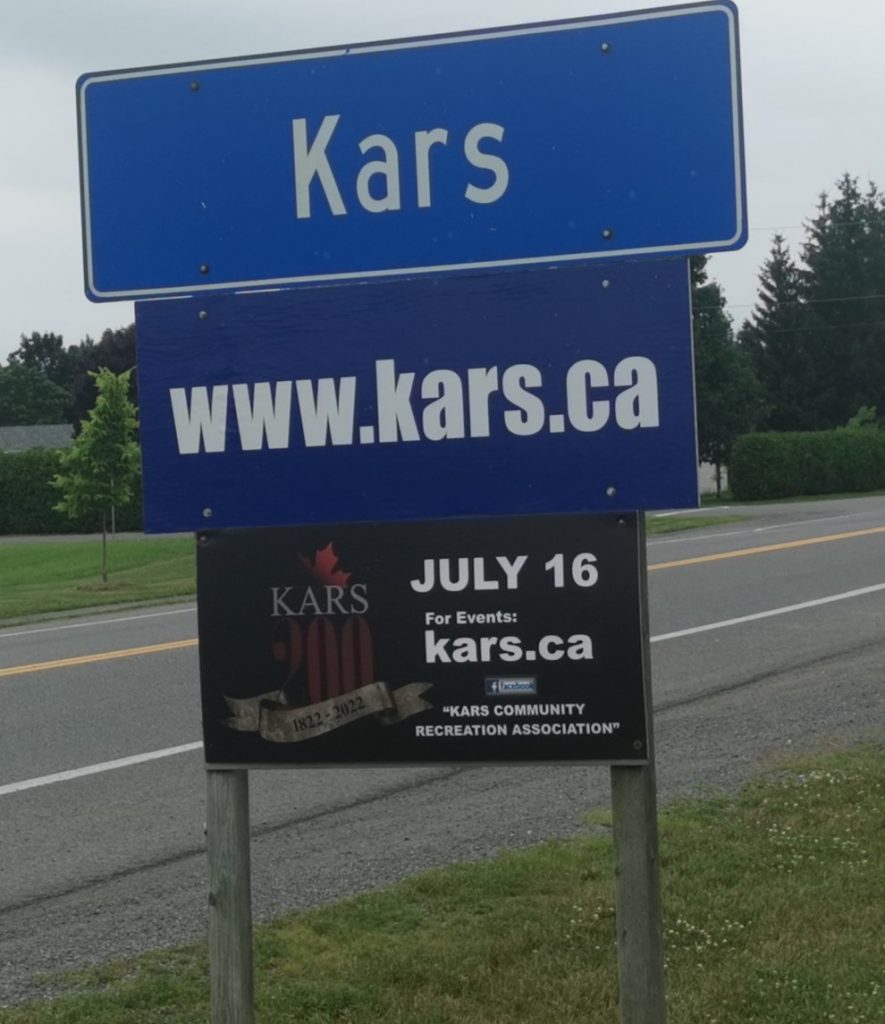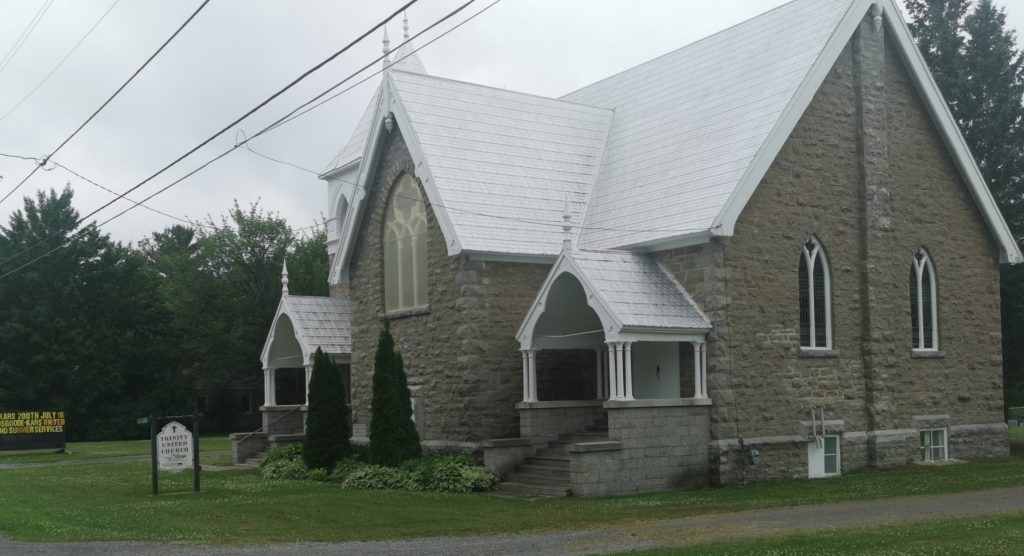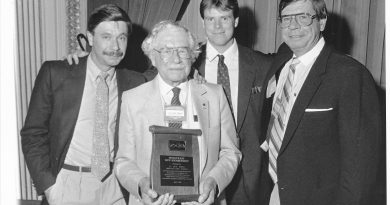Kars Celebrates 200th Anniversary This Weekend
By Manotick Messenger Staff
The year was 1822.
The nearby town of Richmond was still in its infancy. Lyman Clothier and his family had just opened a sawmill, a blacksmith shop and a carding machine for weaving down the river in Oxford-on-Rideau, which would be renamed Kemptville after Upper Canada Governor Sir James Kempt, who is said to have camped along the banks of the Rideau in the area. Osgoode would be founded in 1927. Township C, which was founded in 1792, had been named the Township of North Gower. It was just being settled by United Empire Loyalists. It would be a generation before the Village of North Gower came into existence, and even later than that came Manotick and Bytown, which would be renamed Ottawa.

North Gower Township was named after Admiral John Leveson-Gower, Lord of the Admiralty from 1783 to 1789. In the early 1800s, there was also a South Gower Township.
The Village of Kars will be celebrating its 200th anniversary this weekend. There is a complete day of activities planned for Sat., July 16 at the Kars RA Centre. The day includes activities such as a pancake breakfast, a craft and farmers’ market, a softball tournament, a bouncy castle, face painting, a historic walk of the village, a car show, and historic and military displays. Both Trinity Church and St. Andrew’s Church will also be holding events, including cemetery tours, a barbecue and live music, and a ringing of the bell at Trinity at 11.
A Rich History
Through its 200 years, Kars was not always known as Kars. Wellington Village was the original name of Kars. However, there was also a Wellington Village in Prince Edward County. Mail intended for Wellington (Kars) ended up in Wellington (Prince Edward County) and vice versa. In 1857, Wellington Village changed its name to Kars.
The name Kars was chosen to commemorate the Canadian-born General William Fenwick Williams, who had undertaken the siege of the town of Kars for the Ottoman Empire against the Russian Empire during the Crimean War of the 1850s. Kars was a city in northeast Turkey, and it was the capital city of the Kars Province.
By the 1860s, Kars was a bustling community and shipping centre. Not only was the village on the Rideau, conveniently located between Ottawa and Kemptville, and just south of Manotick, but it was only a mile west of the Ottawa and Prescott Railway. Kars had a sawmill that had capacity of producing three million feet of sawed lumber per year. A.J. Eastman and Co. owned a brewery in Kars that produced 40 barrels of beer per week. There were four general stores, two churches, two wagon shops, a tannery, a school, a cooperage, and a hotel.
The person most responsible for keeping the history of Kars alive for generations to learn and enjoy was the late Coral Lindsay of the Rideau Township Historical Society. An avid local historian, Lindsay wrote a book in 1972, entitled ‘Kars on the Rideau.’ The book is available at Manotick Office Pro.
In 2009, during Manotick’s 150th anniversary, Lindsay chatted with the Manotick Messenger after an event at Dickinson House. Lindsay spoke that day about the earliest settlers in the area. Before the War of 1812, there were only a few families that had settled in Carleton County. The first was Roger Stevens, an American Empire Loyalist from Vermont, who settled the area in 1793.
During the American Revolutionary War, Stevens refused to join the army of the colonies. He was imprisoned in Connecticut, and was ordered to “lay in irons” throughout the duration of the war. Stevens escaped and headed north to Quebec, where he joined the army of British General John Burgoyne. The army fought two battles near Saratoga, NY, losing them both. It was considered the turning point of the war, and Burgoyne surrendered his entire army of 6,200 men. The Americans were being supplied weapons and supplies by France. Burgoyne, who had been a Member of Parliament and a prominent playwright before the war, returned to England.

Stevens and his brother, Abel, were prisoners of war. Once again, he escaped. He joined the Loyalists and acted as a guide on missions, as well as a secret agent.
After the war, Stevens wanted land in Quebec, but was denied. Stevens was to receive 2,000 acres of land, but was only given 400. With the land, he became the first settler of the area. Stevens built a sawmill in the area.
Stevens was one of three settlers in the area. Stephen Burritt, another former soldier, was married to Stevens’ daughter, Martha. They lived about a mile east of the Stevens homestead. Burritt, who was a colonel in the military, had become a fur trader. He founded the settlement known as Burritt’s Rapids.
A year after Burritt built his home, Stevens’ cousin, William Merrick arrived. He settled along the river and was a millwright from Massachusetts.
One of the favourite stories of Lindsay’s was about Stevens’ tragic but strange death, which she said forever linked him to the Village of Kars.
She explained that in 1844, Stevens and Merrick traveled by canoe to the mouth of the Gatineau in search of a site to build a new mill. On the way home, the two men detoured onto a creek.
Lindsay said that Merrick’s version of the story was that Stevens stood up in the canoe to shoot at some ducks. The recoil of the musket knocked him out of the boat, and Stevens drowned.
Martha Burritt did not believe the story. Lindsay said that Martha Burritt knew that her father, an experienced outdoorsman, would never stand up in a canoe to shoot his musket.
The day of the accident, Merrick sent a letter to Governor Haldimand, informing him of Stevens;’ death. Because of the debt Stevens owed to Merrick, Merrick demanded that the Burritt mill and surrounding land be transferred to him. The land is now known as Merrickville.
Stevens Creek was named after Roger Stevens, as was the road that runs from Kars, through North Gower, to Merrickville and Smiths Falls.
School Days
Many families whose names are recognizable to local residents settled the area in the 1820s and 1830s. The Craigs, Grahams, Moffatts, Kerrs, O’Neils, Coles, Phelans, Potters, Johnstons, Doyles, Kellys, Clingins, Youngs, Jamiesons, pollocks, Callanders, Wallaces and Scobies joined the Eastmans, MacEwens, Christies, O’Callaghans, Thomsons and other original families in the new community. The O’Callaghans were the first family from Ireland to settle in Kars. Cornelius O’Callaghan and his wife, Ellen, were from Cork. They sailed to Canada in 1828 with their eight children. One of their children, John, became a key figure in the growth and development of Kars in the first half of the 19th century.
Although the Common School Act for Upper Canada was passed in 1816, families were more focused on surviving in the bush than educating their children.

In her book, Lindsay detailed that the first schoolhouse built in the area was a log structure that was about 18 feet by 18 feet. The school was built in 1832, though Reverend Peter Jones of the Methodist Church was teaching students in his home through the 1820s. Children from the Eastman, Garlick, Lindsay, O’Callahan and O’Connor families.
In 1861, there were two teachers in Kars. Margaret Drew, 21, was the granddaughter of Paul Drew, an early settler on the Prescott Road. Horner Farrer, a 22-year-old Englishman, was the other teacher. He boarded with the Eastman family.
During that school year, there were 63 children who attended school in Kars. Ida Eastman, 5, was the youngest student. The oldest was Eliza Russell, 19.
In her book, Lindsay recounted a story from an incident that was in the Ottawa Citizen:
In this school there were the usual number of pupils who required punishment. On one occasion, a boy of eighteen, an athletic lad, when called up to get a strapping, tried to get out of the door and away. The teacher ran to the door and headed him off. The boy then made a dash for the rear wall, jumped for the trap door (the ceiling was low), caught it and swung himself up. Mr. Farrar tried to follow but the boy, seizing a piece of wood, threatened to brain the teacher if he came up. This incident occurred in the morning and the teacher ate his lunch in the school room so the lad was forced to stay in the attic. At closing time, Mr. Farrar politely invited the boy to come down and take his licking, but the boy refused. The teacher then locked the school and waited outside. Before long, the boy climbed down, quickly opened a window and escaped!
In 1875, the school in Kars burned down. The school trustees hired Solomon Mussell to build a new one-room school out of brick. The design called for a bell tower and a bell. John Kerr was hired as the teacher. He had about 60 students. The school was well-run, and by the 1880s, a wing for senior students had to be added.
In 1905, the main room of the school was divided into two, with the rear wing used as a continuation school. Lindsay said that some recalled having more than 100 students in the school at that time. Because of the number of students, some classes were held in a vacant house at the corner of Nelson and Wellington Streets. Students from Osgoode came to Kars for the continuation, and they also participated in social activities, as well as the hockey and softball games.
Fire destroyed the school in 1945. Lindsay included an article from the Ottawa Citizen on the fire in her book:
Fire of unknown origin destroyed the Kars Continuation and Public School and all its equipment early this morning. The loss was estimated by J. Lawson Greer, chairman of the school board, as $12,000 and was covered by insurance.
Robert Bryan, caretaker, discovered the blaze when he arrived at 5:30 a.m. to find the two-storey concrete block building filled with smoke. He closed up the school and ran one hundred and fifty yards to the home of Mr. Greer who sent out an alarm to neighbours and to the volunteer fire brigade of Osgoode, North Gower and Gloucester through the telephone operator.
Early this morning Mr. Greer and other school trustees Clifford Todd, Gordon Butler, and William Drew were making arrangements for Mrs. Grace Kyer and Miss Laura Hill, principal and assistant of the Continuation School and for Miss Dorothy Clingin and Mrs. Erma Templeton, principal and assistant of the Public School, to finish out the school term. It is planned to accommodate the 75 pupils in the Women’s Institute Hall and the Orange Hall.
The bell crashed to the ground, but it was saved by Wesley Crawford of Kars. The bell had survived two school fires and rebuilds. Mr. Crawford gave it to his wife, who painted it white to use in her garden as a flower pot. Mrs. Crawford eventually donated the bell to the Kars Women’s Institute.
Today, Kars on the Rideau Public School stands where the old Kars Public School was. The site also includes the Kars Cenotaph, used annually for Remembrance Day.
Kars has changed over the years, and also over the last generation. The Kars Fair, complete with its popular demolition derby, disappeared a decade ago. The Kars Dog Show kept going on the fairgrounds site until the pandemic happened. Recreationally, the Kars Aces remain one of the premier Fastpitch softball teams in Eastern Ontario.
The history of Kars has been well preserved by Coral Lindsay, who was named the Manotick Messenger Person of the Year for her work in preserving local history 15 years ago.
For more information on the Rideau Township Historical Society, visit www.rideautownshiphistory.org.





